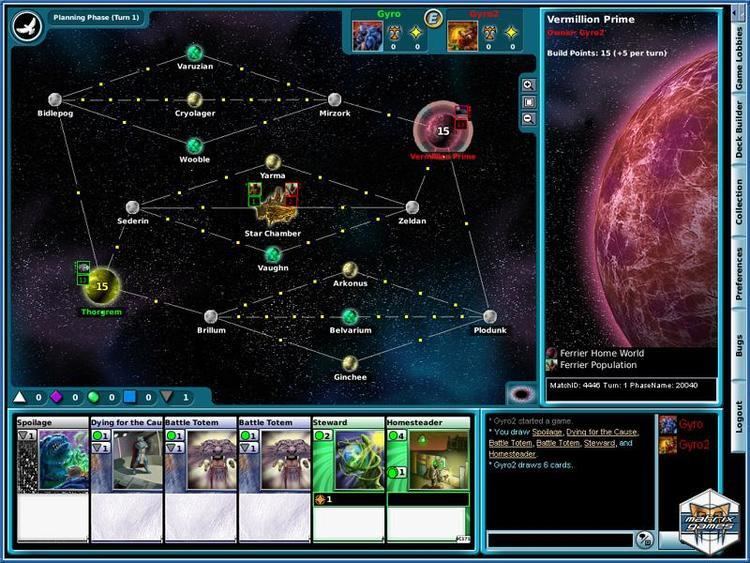10 /10 1 Votes10
Designer(s) Paul Dennen Developer Nayantara Studios | 5/5 Download Initial release date 2003 Publisher Nayantara Studios | |||||||||||||||||||||||||||||||||
 | ||||||||||||||||||||||||||||||||||
Similar Collectible card games, Other games | ||||||||||||||||||||||||||||||||||
Star Chamber was an online collectible card game (CCG) first released as just "Star Chamber" in 2003 by Nayantara Studios, later owned by Matrix Games and Worlds Apart Productions, and now owned by Sony Online Entertainment. The game ran on both the Microsoft Windows and Mac OS X platforms. It was free to download and play, with additional cards available for purchase. There was one base set and five expansion sets released for Star Chamber.
Contents
- Techs
- Races
- Voting
- Winning
- Original Development
- Phantom Tournaments
- Expansion Sets
- Shutdown and Game Closure
- References
On March 30, 2012, Sony Online Entertainment removed server support for the game, and it is no longer playable.
The game could be played as single-player (in practice matches, in "skirmish" matches, or with any of four campaigns, each of which comprises seven separate scenarios) or with between two and four players live over the internet. Two-player games usually required half an hour to complete, while three- and four-player games average closer to an hour.
One of the game’s primary distinctions was that it combined traditional CCG elements (card collecting and trading, deck building, the use of cards in-game, etc.) with a board wargame-style map and unit production based on locations on that map, in some ways similar to the classic Master of Orion series. There were 43 unique maps, with random elements incorporated into some of those maps. The titular Star Chamber is a location at which voting session between players’ citizens took place every sixth turn. Players voted for the Power Play, Alien Support, and Peacekeepers (see Voting below).
Techs
There were five different technologies, or "techs," in Star Chamber. Each tech represented a different facet of sentient society:
Races
There were ten different races in Star Chamber, each of which combined two techs:
Voting
After every sixth turn, a voting session took place at the Star Chamber location. Players’ citizens had to be present at the Star Chamber location in order to vote, and each citizen usually had one vote. Cards could be played in order to increase or decrease the number of votes each citizen received.
Players distributed their votes between three categories:
Winning
There were three ways to win a game of Star Chamber: Military Victory (conquering the opponent’s homeworld), Cultural Victory (having a "destiny point" advantage of 30 or more points; destiny points are generally gained by controlling "artifact planets"), and Political Victory (winning three Power Play votes).
Since there was a vote being held every 6 turns and a powerplay won each of those voting sessions, a 2 player game could never last more than 30 turns. This was an elegant game design choice that prevented long drawn out stalemates.
Star Chamber had a fluent flow between the three different win conditions and one of the best players once said aptly: "You don't choose how you win in star chamber, your opponent chooses how to lose." This was frequently true, because any one was usually easy to defend, but would leave one or two other paths vulnerable.
Original Development
Star Chamber was originally developed by Nayantara Studios, set up by Paul Dennen, known in the game as 'merakon' and 'ender'. This company was named after his cat, a name which means something akin to 'eyes of stars'. Most of this development was done while he worked at it alone, getting help only very late in the development process. Paul Dennen was frequently found online and sometimes playing games and helped create an open, positive and constructive atmosphere that is very uncommon in online games.
Phantom Tournaments
Before Star Chamber was controlled by Worlds Apart, it featured phantom sealed deck Tournaments. This required a single ticket at the price of a dollar and was a complete sealed deck experience, with the one difference that you didn't get the keep the cards you drafted; only the prizes. These were very popular.
Expansion Sets
Expansion sets were divided into "blocks", which fit into the Star Chamber storyline
Origins Block:
Harbinger Block:
Shutdown and Game Closure
Star Chamber:The Harbinger Saga was shut down on March 29, 2012. As compensation, Sony Online Entertainment offered players 3 months of Gold Membership in the online fantasy role-playing games EverQuest and EverQuest II. These memberships became available on March 16, 2012.
